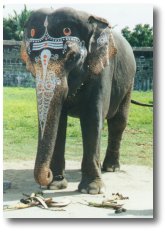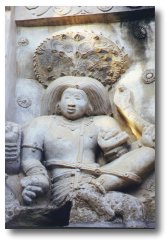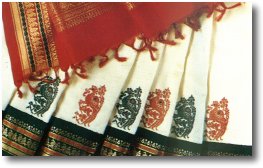
|
The ancient Tamil empire spread out into what are now the states of Tamilnadu, Kerala,  and
some parts of Andhra Pradesh. There were three major Tamil kingdoms, namely
the Chera, Chola, and the Pandiya kingdoms. In addition, there were smaller
kingdoms like the Thondai and Kongu mandalams. Kanchipuram is believed
to have been the capital city of the Thondai mandalam. There were periods
when this region was under the rule of the Chola kingdom. It has also been
under the Great Pallava dynasty for the longest period of time. The Pallava
rule is said to have been the Golden period for the city of Kanchipuram,
as well as Hindu arts and architecture. Each of the dynasties which ruled
Kanchipuram has left historical monuments to speak of its glories. and
some parts of Andhra Pradesh. There were three major Tamil kingdoms, namely
the Chera, Chola, and the Pandiya kingdoms. In addition, there were smaller
kingdoms like the Thondai and Kongu mandalams. Kanchipuram is believed
to have been the capital city of the Thondai mandalam. There were periods
when this region was under the rule of the Chola kingdom. It has also been
under the Great Pallava dynasty for the longest period of time. The Pallava
rule is said to have been the Golden period for the city of Kanchipuram,
as well as Hindu arts and architecture. Each of the dynasties which ruled
Kanchipuram has left historical monuments to speak of its glories.
When Buddhism later lost its roots in the country of its origin and continued to be practised in the south-eastern parts of Asia, Hinduism made Kanchipuram an entirely new city in all aspects. Kanchipuram and its neighboring cities became celebrated centers for Hindu architecture and arts. Not many of those monuments exist now. But, the region still has Kanchipuram and Mahabalipuram to talk about the glory of the period.
The Silk industry along with the city being the Capital of a Kingdom also brought people from various other parts of India over the years. Today's Kanchipuram is a cosmopolitan city with people speaking several languages.Other than the native Tamil, languages like Telugu, Kannada, and Saurashtra are also prevalent in the city. With the Sankara Mutt acting as the hub of Hindu activities and the temples, Kanchipuram is still one of the most highly visited pilgrimage spots in India, and can rightfully be called the "Religious Capital of South India".
Surprisingly, the 'religious capital of South India' is also the 'Atheistic capital of South India'. The strongest ever anti-hinduism movement in India, namely the Dravidian Movement has had very strong roots in the city. Some of the movement's eminent leaders like Arignar Anna were born and bred in Kanchipuram. Kanchipuram was also the birth place of the first political offshoot of the Dravidian movement, the Dravidar Kazhagam. |
 In
the early days, this city is said to have been built in the shape
of a Peacock. Before the advent of Hinduism, this city had been a center
for Buddhism. There have been a few monasteries in the city, from which
monks travelled to eastern Asia to spread the religion. One among the prominent
Buddhist monks who lived in the city is Bodhi Dharma.
In
the early days, this city is said to have been built in the shape
of a Peacock. Before the advent of Hinduism, this city had been a center
for Buddhism. There have been a few monasteries in the city, from which
monks travelled to eastern Asia to spread the religion. One among the prominent
Buddhist monks who lived in the city is Bodhi Dharma.
 Today,
Kanchipuram is a small, rural town about 75 kilometres from Chennai (Formerly,
Madras) in the state of Tamilnadu. It also serves as the district head
quarters for the Chengalpattu district. Its economy is entirely dependent
on Tourism and the well established handloom industry. Kanchipuram has
thousands of handlooms and skilled weavers that make its silk sarees one
of the best in the entire world. About 75% of the city's population is
associated with the handloom industry in some way.
Today,
Kanchipuram is a small, rural town about 75 kilometres from Chennai (Formerly,
Madras) in the state of Tamilnadu. It also serves as the district head
quarters for the Chengalpattu district. Its economy is entirely dependent
on Tourism and the well established handloom industry. Kanchipuram has
thousands of handlooms and skilled weavers that make its silk sarees one
of the best in the entire world. About 75% of the city's population is
associated with the handloom industry in some way.
 Moreover,
almost all other religious cities in India support one of the two sects
in Hinduism - Vaishnavism and Saivism. Kanchipuram has lended itself equally
to both the sects, dividing itself into Vishnu Kanchi, surrounding the
Varadaraja Perumal Temple, and Siva Kanchi, surrounding the Ekambaranathar
Temple, while the Kamakshi Amman Temple stands in between as a place of
Shakthi worship.
Moreover,
almost all other religious cities in India support one of the two sects
in Hinduism - Vaishnavism and Saivism. Kanchipuram has lended itself equally
to both the sects, dividing itself into Vishnu Kanchi, surrounding the
Varadaraja Perumal Temple, and Siva Kanchi, surrounding the Ekambaranathar
Temple, while the Kamakshi Amman Temple stands in between as a place of
Shakthi worship.